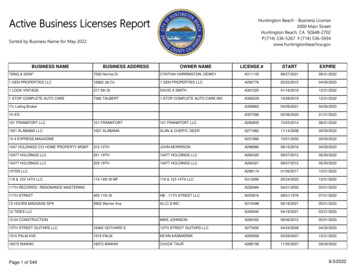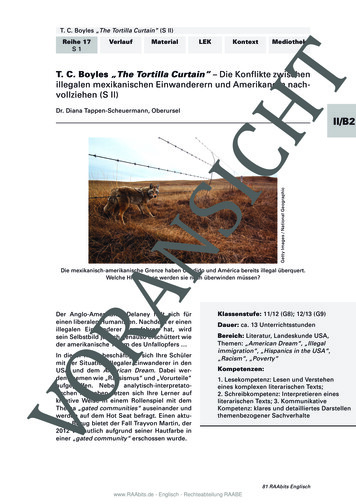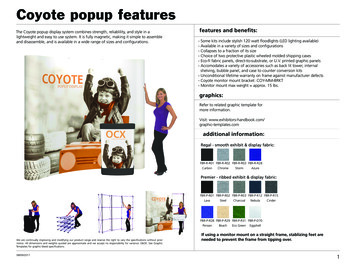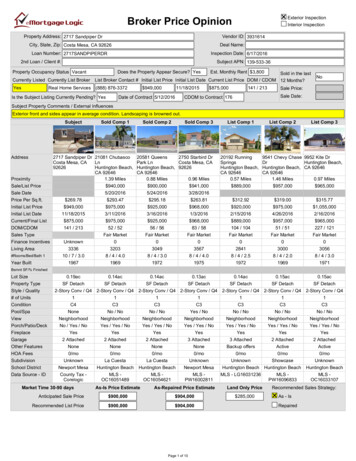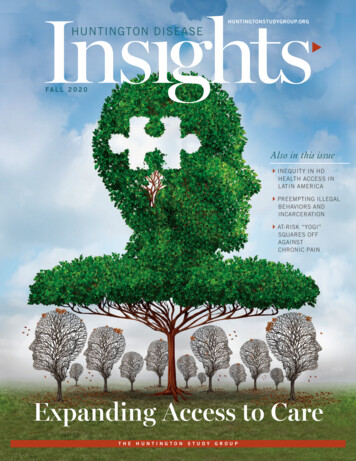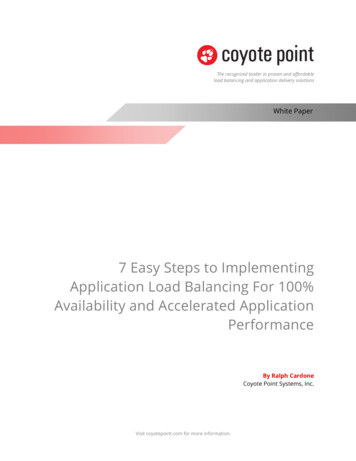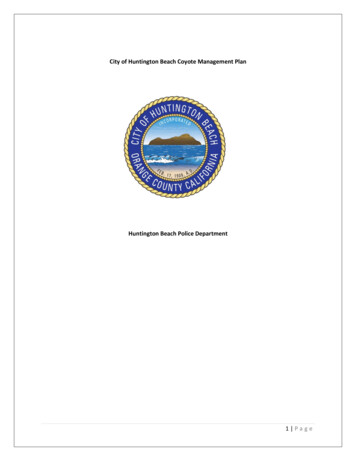
Transcription
City of Huntington Beach Coyote Management PlanHuntington Beach Police Department1 Page
City of Huntington BeachCoyote Management PlanTable of ContentsExecutive SummaryPage 3I.BackgroundPage 4II. The CoyotePage 4III. Coyote Attractants in Urban AreasPage 6IV. Hazing and Behavioral ChangesPage 8V. Monitoring and Collecting DataPage 9VI. EnforcementPage 10VII. Response & Attack PlanPage 10VIII. Public Education and OutreachPage 11Appendix A – Definitions and Encounters with CoyotesPage 12Appendix B – Coyote Behavior ClassificationPage 14Appendix C – Hazing Program and Training PlanPage 16Appendix D – Yard Audit ChecklistPage 20Appendix E – ReferencesPage 212 Page
City of Huntington BeachCoyote Management PlanExecutive SummaryThe intent of this plan is to provide guidance for staff in dealing with coyotes in Huntington Beach. TheManagement Plan is based on research and best known management practices and includes a fullspectrum of management tools to deal with coyotes in an urban area. This Coyote Management Plan isbased on case studies, best management practices implemented by surrounding communities, and anunderstanding of the coyote ecology and biology in urban settings.GoalsThe goal of this Management Plan is to support coexistence with urban coyotes using education,behavior modification, and development of a tiered response to aggressive coyote behavior. Thesuggested actions in this plan are designed to increase citizens’ knowledge and understanding of howcoyotes behave and make clear how such behavior can be managed to reduce or eliminate conflicts withcoyotes.StrategyThe strategy for managing coyotes is based on balancing respect and protection of wildlife and theirhabitats without compromising public safety. The main strategy is comprised of a three prongedapproach consisting of:1. Public Education designed around co-existence with coyotes.2. Enforcement of laws and regulations prohibiting the feeding of wildlife.3. Ensuring public safety by implementing appropriate tiered responses to coyote and humaninteractions. This plan requires active participation on the part of the entire community.EducationEducation is the key to having residents make appropriate decisions regarding their safety or managingtheir property and pets. Education will involve written materials on doors and handouts available at Cityfacilities. Educational tools will also include signage that will warn pet owners of the presence ofcoyotes. The goal of education is to decrease attractants, increase pet safety, and reshape coyotebehavior through hazing and creating reasonable expectations of normal coyote behavior.EnforcementThe act of feeding wildlife is known to lead to an increase in wildlife activity. Feeding can attract coyotesand their prey to an area leading to an increased likelihood of creating a habituated coyote(s) resultingin increases in coyote and human interactions. California law strictly prohibits feeding wildlife. Section13.48.075 of the Huntington Beach Municipal Code prohibits the feeding of wildlife on City property.Response PlanA detailed tiered response plan has been developed to provide a mechanism for identifying andclassifying different levels of human and coyote interactions. Definitions of coyote encounters are listedin Appendix A. Appendix B provides a chart detailing coyote behavior, behavior classification, andrecommended responses.3 Page
City of Huntington BeachCoyote Management PlanI.BackgroundThe City of Huntington Beach does not own or have any control of the wild animals found within itsboundaries, nor is the City responsible for the actions of damage caused by them. These animals area common and important part of our natural ecosystem.The City of Huntington Beach contracts with Orange County Animal Care and City staff do notrespond to calls for service for normal coyote behavior, such as sightings. However, the HuntingtonBeach Police Department (HBPD) does track coyote sightings, aggressive behavior, and attacks.Although the City of Huntington Beach places a high value on wildlife, some individual animalsadapted to urban environments have the potential to cause problems and/or conflicts in specificsituations. In addressing problems, the City promotes policies supporting prevention andimplementation of remedial measures that do not harm the wildlife or their habitats.A wildlife problem is defined as any situation that causes a health or safety issue to its residents. Incases where problems with wildlife are associated with human behavior (leaving garbage exposed orintentional wildlife feeding), ordinances and enforcement may be enacted to minimize conflict.In some instances, traditional management tools toeffectively manage urban wildlife are ineffective.For example, relocation of coyotes is not ecologicallysound and in many instances is prohibited by theCalifornia Department of Fish and Wildlife (CDFW).Generally, relocated animals do not survive thetransfer. If they do, they rarely stay in theirrelocated area and tend to disperse to otherlocations where they may cause problems tohumans, be involved in territorial disputes, orintroduce disease.In some instances, thetranslocated coyote will go to great lengths to return to its previous home. For these reasons, theCDFW rarely allows relocation.As a last resort, lethal control measures, when employed are controversial and non-selective; theytarget the alpha coyote or “problem” coyote. If they are used, they must be humane and incompliance with federal and state laws.It is not economically, or ecologically justified to attempt to remove all coyotes from the urbanecosystem as a means of addressing conflicts between humans and coyotes. Attempts made bylocal, state, and federal agencies as well as private organizations over the past century have provento be ineffective.II.The Coyote (Canis Iatrans)Coyotes are originally native to California and several other western states. Due to theirintelligence, adaptability, and the decline of other predatory species due to urban sprawl, coyotes4 Page
City of Huntington BeachCoyote Management Planhave sccessfully expanded their range. Coyotes are now found in all states except Hawaii and havesucessfully established themselves in every urban ecosystem across North America.Coyotes play an important role in the urban ecosystem, particularly as a top-predator. They eat abroad range of small animals, including squirrels, mice, rabbits, rats, and gophers. Rodents make upa majority of their diet. In the process, they control the population sizes of these animals, many ofwhich are considered pests to humans. The coyotes also prey on “mesopredators,” such asraccoons and oppossums. Without a top predator like the coyote to keep them in check,mesopredators can dramatically reduce bird populations by eating their eggs (Crooks and Soule,1999). Coyotes also disperse seeds of native plant species and recycle nutrients.It is hard to track and inventory coyote populations, making it difficult to know if the number ofcoyotes has increased in a particular area. What is known is that coyotes can become habituated tohumans if they are intentionally or unintentionally fed, which can lead to loss of fear of people andbolder behavior. In general, coyotes regularly roam an area of about two to five square miles toobtain enough food for the pack members. Normally, each pack is a territorial family group madeup of three to ten individuals. A portion of the area the pack inhabits is the pack’s territory, whichthey will defend from other coyotes. The number of mature coyotes in the pack is often related tothe amount of food resources in the territory.A coyote pack usually has only one breeding (or alpha) female. This female often produces morepups than can be supported by the pack. Young coyotes may leave the pack at about nine to elevenmonths of age, but dispersal patterns are highly variable. These juvenile coyotes become transients.Other types of transients include older individuals that can no longer defend their role as upper levelpack members and are pushed out of the pack.Transient coyotes move all over in narrow undefended zones that exist between pack territoriessearching for an open habitat to occupy or group to join. They often die before they succeed (manyare hit by vehicles). It is largely because of the constant influx of transients, that coyote eradicationprograms fail.Removing a group of territorial coyotes will create anundefended area into which the transient coyotes willflow. At all times of the year, numbers of transients areimmediately available to replenish any voids created bykilling resident coyotes. Furthermore, if either thealpha male or alpha female in a pack is killed, ovulationin other breeding-age females is often triggered and acorresponding increase in the number of litters and/ornumber of pups per litter is observed.Coyote Appearance - What do Coyotes Look Like?Coyotes vary in color from gray-brown to yellow-gray. Their backs have tawny-colored underfur andlong overcoats with black-tipped guard hairs. The latter forms a dorsal stripe and dark band overtheir shoulders. Their throats and bellies tend to be buff or white in color. Coyotes have long legs,small paws, large pointed ears, and a pointed snout. Weighing between 15 and 40 pounds, but theirlong legs can make them appear larger.5 Page
City of Huntington BeachCoyote Management PlanHow and Where do Coyotes Live?Coyotes may live alone, in pairs, or in family groups with one breeding pair, generally mating once ayear, usually January through February. Social organization and group size are highly correlatedwith food availability. The rest of the group is comprised of multiple generations of offspring. Pupsare born March through May. The entire group protects the pups though pup mortality averagesbetween 50 and 70 percent in the first year. Litter size depends on available resources and thenumber of coyotes in the area.Although a litter varies from two to twelve pups,the average is six or seven. Pups remain in theden the first six weeks and then travel with theadults. By the end of the summer; they aremore independent, yet, may still travel withparents and siblings.Because coyotes are socially organized, thegroup raises the young and defends their territory from other coyotes. Territories do not overlap.Although they generally live in groups, coyotes often travel alone or in pairs.In the urban areas, most coyotes live in large parks, golf courses, greenbelts, and natural open spacewhere they find food and cover. Thus, their territory may follow the park or open space boundaries.They are extremely adaptable in creating territories under a wide range of urban conditions.How do Humans Perceive Coyotes?People respond to coyotes in various ways. Some observe them with enjoyment, others withindifference and some with fear or concern. Experiences range from animal sightings withoutincident, to stalking, killing of pets or, at the extreme, an attack on a person. Coyote attacks onhumans are very infrequent. Although such incidents generate significant media coverage, theyremain a very rare event.Because wild animals conjure up fear in some people, actual sightings and perceptions may becomeexaggerated or misconstrued (see Appendix A). The wide range in perceptions of urban coyotesfrom Huntington Beach residents supports the need for strong and consistent educational messagesto clarify management techniques.III.Coyote Attractants in Urban AreasCoyotes are drawn to urban and suburban areas for the following reasons:1. Food – Urban areas often support large numbers of rodents, including mice and rats. However,coyotes can be further attracted into suburban neighborhoods by human-associated food suchas pet food, unsecured compost or trash, and fallen fruit. Intentional and unintentional feedingcan lead coyotes to associate humans with sources of food, which can result in negativeinteractions among coyotes, people, and pets. To reduce food attractants in urban andsuburban areas: Never hand feed or otherwise deliberately feed a coyote.6 Page
City of Huntington BeachCoyote Management Plan Avoid feeding pets outside. Remove sources of pet food and water that a coyote couldeasily access. If feeding pets outside is necessary, promptly remove the bowl and anyleftover food. Never include meat or dairy in a compost pile. Maintain good housekeeping, such as regularly raking areas around bird feeders. Remove fallen fruit from the ground. Keep trash in high-quality containers with tight-fitting lids. Only place the cans curbsidethe morning of collection. If left out overnight, trash cans are more likely to be tippedover and explored. Bag especially attractive food wastes, such as meat scraps or leftover pet food beforediscarding.2. Water – Urban areas provide a year-round supply in the form of stormwater runoff, artificiallakes, irrigation, pet water dishes, etc., which support both coyotes and their prey. During drought or otherwise dry conditions, water can be as alluring as food, so removewater bowls set outside for pets and make watering cans unavailable.3. Access to Shelter – parks, greenbelts, open spaces, golf courses, buildings, sheds, decks andcrawl spaces, etc., increase the amount of variability of cover for coyotes. They allow coyotes tosafely and easily remain close to people, pets, homes and businesses without detection. In the spring, when coyotes give birth and begin to raise young, they concentrate theiractivities around dens or burrows in which their young are sheltered. Coyotes may takeadvantage of available spaces under sheds or decks for use as a den, bringing them intoclose contact with people and pets.4. Unattended Pets – Pets are a normal part of an urban landscape. Within their territory, coyotesmay consider pets as potential prey or potential competitors. Free roaming pets, especially cats and sometimes small dogs, may attract coyotes into aneighborhood. The best way to minimize risk to pets is to not leave them outsideunattended. Cats – Coyotes primarily eat small mammals such as mice and rats, but will also prey onslightly larger mammals such as rabbits and groundhogs. Approximately the same sizeas a groundhog or rabbit, free-roaming outdoor cats may also be seen as eligible preyitems by coyotes. It is important to note that attacks on cats are normal coyotebehavior and do not indicate danger for humans. The best way to protect cats fromcoyotes (and the other dangers of outside life, such as cars, disease, dogs, and otherwildlife) is to keep cats primarily indoors and only let them outside in a secure enclosureor when accompanied by a person and under the control of a leash and/or harness.7 Page
City of Huntington BeachCoyote Management Plan Feral Cats – People who feed feral cats are often concerned that coyotes might prey onthe cats. These concerns are well founded, as coyotes can be attracted to the outdoorpet food. Although there is no sure way to protect feral cats from coyotes the followingtips can be helpful:i. Do not feed feral cats. Doing so can have other unintentional consequences,including ecological damage.ii. Provide escape routes for cats.iii. Haze coyotes seen on the property (see Appendix C).Making them feeluncomfortable will encourage them to stay out of the area. Dogs – Dogs are also vulnerable to coyote confrontations. These incidents generallyinvolve coyotes who are accustomed or habituated to people (usually from feeding), orcoyotes who are protecting their territory and pups (usually during breeding season).Small, unattended dogs may be seen as potential prey. It is important to either keepdogs on a six-foot long or shorter leash when outdoors or to stay within six feet of themwhen on your property. Coyotes may view a dog on a leash longer than six feet as anunattended pet. This is especially important if you are in or near nature preserves oropen-space areas. Attacks on unattended, small dogs are normal coyote behavior anddo not indicate a danger to people.Although attacks on larger dogs are rare, coyotes will sometimes go after a large dogwhen they feel that their territory is threatened. This generally occurs during the coyotebreeding season, which takes place from January through March. During this time, it isespecially important not to let dogs outside unattended and to keep them on leashes(six feet long or less) when in public areas. Do not allow dogs off leash, it is against thelaw and is unsafe.Other domestic animals kept outside, such as rabbits, may also be viewed as prey by coyotes.Protect outdoor animals from coyotes (and other predators) with protective fencing and/or confinethem in sturdy cages each evening. Residents are encouraged to use the Yard Audit Checklist(Appendix D) as a tool to help recognize and remove attractants in their yards and neighborhoods.While human attacks are very rare, urban landscape development, habituation through intentionaland unintentional feeding, pet related incidents and media attention have led some urban residentsto fear coyotes. Steps must be taken to address safety concerns, misconceptions, and appropriateresponses to potential threats to human safety. It is important to keep in mind that coyotes havebeen in and around Huntington Beach for a very long time.IV.Hazing and Behavioral ChangeHuman behavior can shape animal behavior, in either a negative or positive manner. People living inclose proximity to coyotes can remove coyote attractants, identify potentially dangerous situationsfor their pets and themselves, and respond in a manner designed to change coyote behavior.8 Page
City of Huntington BeachCoyote Management PlanOverview of HazingHazing is a process whereby a person or a number of individuals encountering a coyote respond inlike manner to make a coyote afraid and choose to leave a situation where their presence isunwanted. The following are various types of hazing methods: Basic Hazing – This method consists of standing your ground, never ignoring or turning yourback to a coyote(s), and yelling and/or making unpleasant and frightening noises until theanimal(s) choose to leave. If the coyote does not leave, more aggressive tactics are in order. More Aggressive Hazing – This consists of approaching an animal more quickly andaggressively, throwing projectiles like stones near, but not at, the animal, spraying with ahose or water gun, or creating more heightened fear of contact so the animal flees. Formore options, see Appendix C on haxing.Hazing must continue once it begins until the animal leaves. Otherwise, the coyote will learn to“wait” until the person gives up. Not following through with hazing will create an animal moreresistant to hazing instead of reinforcing the image that “people are scary.” Hazing never involvesinjury to the animal, only threat of injury. An injured animal becomes less predictable than a normalhealthy one.A common concern with hazing involves potential danger to the hazer. A coyote’s basic instinct isvery skittish and this nature is what makes the technique useful. A normal healthy coyote is veryunlikely to escalate a situation with a person who is aggressively hazing. It is important that thehazer provides the coyote a clear escape route free to flee and not corner the animal. A corneredanimal may decide that attacking the hazer is the only option.Elements of an effective hazing campaign include:1. Pet owners need to protect pets. Off-leash and unattended dogs and cats attract coyotes (asdoes pet food).2. Residents need to learn hazing effectiveness and techniques. A hazing program must beinstituted, maintained and evaluated on a regular basis.3. Hazing needs to be active for a sustained period of time to achieve the desired change inbehavior.4. Hazing requires monitoring to assess its effectiveness and to determine if further action or moreaggressive hazing is needed.V.Monitoring and Collecting DataMonitoring and collecting data on coyote populations, sightings, and attacks are critical componentsof an effective Coyote Management Plan. This is best accomplished with input from both residentsand city officials. Coyote sightings or incidents can be reported to the Huntington Beach PoliceDepartment at (714) 536-5913 or online at http://www.huntingtonbeachca.gov/i want to/coyoteincident-report.cfmThe purpose of monitoring human-coyote interactions is to document where coyotes are frequentlyseen and to identify human-coyote conflict hotspots (if they exist). Gathering specific data onincidents will allow for targeting of educational campaigns and conflict mitigation efforts, as well asthe ability to measure success in reducing conflicts over time.9 Page
City of Huntington BeachCoyote Management PlanVI.EnforcementThe act of feeding wildlife is known to lead to an increase in wildlife activity. Feeding can attractcoyotes and their prey to an area leading to an increased likliehood of creating habituated coyote(s)resulting in increases in coyote and human interactions. California law prohibits feeding wildlife.Huntington Beach Police Officers, Orange County Animal Control Officers, and Huntington BeachCode Enforcement Officers will strictly enforce State law(s) and Huntington Beach Municipal CodeSection 13.48.075 pertaining to this activity. The following will be enforced:California Code of Regulations Title 14§251.1. Harassment of AnimalsExcept as otherwise authorized in these regulations or in the Fish & Game Code, no person shallharass, herd or drive any game or nongame bird or mammal or furbearing mammal. For thepurposes of this section, harass is defined as an intentional act which disrupts an animal’snormal behavior patterns, which includes, but is not limited to breeding, feeding, or sheltering.City of Huntington Beach Municipal Code Title 1313.48.075 Feeding Widlife on City Property ProhibitedUnless specifically authorized by the Director of Community Services in writing, no person shallfeed, disturb, or have physical contact with wildlife on City property.VII.Response and Attack PlanA detailed tiered response plan has been developed to provide a mechanism for identifying andclassifying different levels of human and coyote interactions. Definitions of coyote encounters arelisted in Appendix A and Appendix B provides a chart detailing coyote behavior, behaviorclassification, and recommended responses.If a human is attacked and physically injured by a coyote, the Huntington Beach Police Departmentwill lethally remove the offending animal and/or contact the California Department of Fish andGame. City staff may then work to lethally remove the responsible coyote(s). Since coyotes areconsidered “non-game wildlife” any resident or Homeowner’s Association Board of Directors caninitiate, at their own expense, action to protect themselves and their private property from coyoteattacks.Threat Level Tiered ResponseLevel GreenLevel YellowLevel OrangeBehavior – A coyote is seen or heard in an area. Sighting may be during the day ornight. Coyote may be seen moving through the area.Response – Education and hazing needed.Behavior – A coyote appears to frequently associate with humans or human-relatedfood sources and exhibits little wariness of human presence. Coyote is seen duringthe day resting or continuously moving through an area frequented by people.Response – Education and aggressive hazing needed, volunteer hazing teamcreated.Behavior – A coyote is involved in an incident(s) where there is a domestic animal10 P a g e
City of Huntington BeachCoyote Management Planloss. Several level orange incidents in the same general area may indicate thepresence of a habituated coyote(s).Level RedResponse – Education and aggressive hazing needed, volunteer hazing teamcreated, and public awareness of incident(s) and circumstances addressed. Ifmultiple level orange incidents have occurred in the same vicinity within a shortamount of time, lethal removal may be recommended.Behavior – A coyote that has been involved in an investigated and documentedprovoked or unprovoked close encounter or attack on humans.Response – City staff may work to lethally remove the responsible coyote(s) after athorough investigation of the incident(s).VIII.Public Education and OutreachEducation is the key to having residents make appropriate decisions regarding their safety ormanaging their property and pets. This involves decreasing attractants, increasing pet safety, andcreating reasonable expectations of normal coyote behavior.Learning how to repsond to a coyote encounter empowers residents and can help reduce undesiredcoyote behaviors. The public should understand what normal coyote behavior is when living in closeproximity with coyotes. For example, vocalization is normal acceptable behavior and does notindicate aggression. Education and outreach efforts by the City will focus on: Understanding human safety, pet safety, coyote attractants, deterrents to coyotes onprivate property, including appropriate fencing, exclusion techniques, “what to do” tips, andinfromation on appropriate hazing techniques. Developing a common language and awareness of normal versus abnormal behavior whendiscussing encounters with coyotes (see definitions in Appendix A). Dissemination of information to residents, businesses, and schools through the City’swebsite, Channel 3, social media, traditional media, fliers/handouts, mailers, etc. Consulting with land managers, non-profit organizations (e.g. The Humane Society), andagencies like the California Department of Fish and Wildlife that provide public educationmaterials, programs, and expertise.11 P a g e
City of Huntington BeachCoyote Management PlanAppendix ADefinitions of Encounters with CoyotesActive Coexistence – Humans and coyotes exist together. Humans take an active role in keepingcoyotes wild by learning about coyote ecology and behavior, removing attractants, taking responsibilityfor pet safety, and hazing coyotes in neighborhood or community spaces (except for predeterminedcoyote-appropriate areas). Hazing is not appropriate in a designated nature reserve or similar openspace, unless the coyote exhibits threatening behavior to persons or leashed pets.Attack – A human is injured or killed by a coyote.Provoked – A human-provoked attack or incident where the human involved encourages thecoyote to engage. Examples include dogs off-leash in an on-leash area, dogs on leashes longerthan 6’ in length, or a human intentionally corners, injures, tries to injure, attempts to captureor feeds the coyote.Unprovoked – An unprovoked attack or incident where the human involved does not encouragethe coyote to engage.Pet AttackAttended animal loss or injury – When a person is within 6’ of the pet and the pet is on leashand is attacked and injured or killed by a coyote.Domestic animal loss or injury – A coyote injures or kills a pet. Also includes “depredation”predation of domestic pets. Animal loss or injury is considered the result of normal coyotebehavior.Subjected Pet Attack – A coyote is an opportunistic feeder and may feed on recently dead or dyinganimals, especially cats that were hit or killed by cars or other means. The eaten remains may be foundand suggest the animal was attacked by a coyote. In cases where Animal Control Officers respond tothese calls, without knowledge of an actual attack, the incident will be recorded as a suspected attack.Encounter – An unexpected, direct meeting between a human and a coyote that is without incident.FeedingIntentional Feeding – When a person or persons actively and intentionally feeds coyotes orprovides food for animals in the coyote food chain.Unintentional Feeding – When a person or persons are unintentionally providing access to food.Some examples are accessible compost, fallen fruit from trees, open sheds and doors, and petfood left outdoors.Unintentional Feeding (Bird Feeders) – When a person or persons bird feeders inadvertentlyprovides food for coyotes (e.g. birds, bird feeders, rodents, and squirrels). Bird feeders must bekept high enough from the ground so a coyote is unable to reach the feeding animals. The areaunder the bird feeder must be kept clean and free of residual bird food.12 P a g e
City of Huntington BeachCoyote Management PlanHazing – A training method that employs immediate use of deterrents to move an animal out of an areaor discourage undesirable behavior or activity. Hazing techniques include loud noises, spraying water,bright lights, throwing objects near but not at the animal, and shouting. Hazing can help maintain acoyote’s fear of humans and deter them from neighborhood spaces, such as backyards and play spaces.Hazing does not and should not injure or damage animals, humans, or property.Threat Incident – A conflict between a human and coyote where the coyote approaches a human andgrowls, bares teeth or lunges; injures or kills an attended domestic animal. A human is not injured.Stalking Incident – A conflict between a human and a coyote, where the coyote follows a person with orwithout an attended pet on a leash. A human is not injured.Observation – The act of noticing or taking note of tracks, scat, or vocalizations.Sighting – A visual observation of a coyote(s). A sighting may occur at any time of the day or night.Unsecured Trash – Trash that is accessible to wildlife (e.g. individual garbage cans, uncovered or opendumpsters or bags, trash cans overflowing, or where scattered trash is outside the receptacle).13 P a g e
City of Huntington BeachCoyote Management PlanAppendix BCoyote Behavior ClassificationCoyote ActionCoyote HeardClassificationObservation Level GreenCoyote Seen Moving inAreaCoyote Seen Resting inAreaCoyote Seen Resting inArea with PeoplePresentSighting Level GreenCoyote Entering a Yardwithout PetsCoyote Entering a Yardwith PetsSighting Level GreenSighting Level YellowSighting Level YellowEncounter Level YellowCo
obtain enough food for the pack members. Normally, each pack is a territorial family group made up of three to ten individuals. A portion of the area the pack inhabits is the pack's territory, which they will defend from other coyotes. The number of mature coyotes in the pack is often related to the amount of food resources in the territory.

